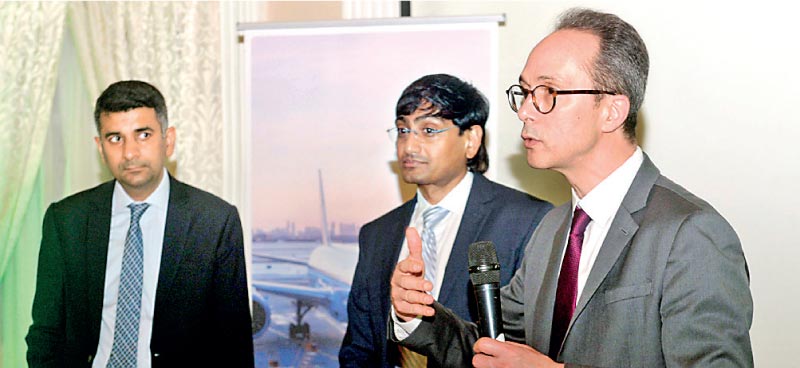Thursday Feb 27, 2025
Thursday Feb 27, 2025
Thursday, 18 July 2024 05:00 - - {{hitsCtrl.values.hits}}

The Geneva-based SITA CEO David Lavorel (right) with Asia Pacific President Sumesh Patel and Vice President Sales India and Subcontinent Vilpul Seth – Pic by Sameera Wijesinghe
By Nisthar Cassim
The global leader in technology solutions for the air transport industry, SITA has come up with a comprehensive study on how to improve the passenger experience and operational efficiency of airlines at the Bandaranaike International Airport (BIA) in response to Sri Lanka’s challenge of catering to 14 million travellers over the next four years from 10 million this year.
The four-month long study was following a request from Sri Lanka travel and aviation authorities and covers seven key touch points of a traveller including border control.
The completion and handover of the 208-page study was announced in Colombo on Tuesday during the first ever visit by a SITA CEO in its 75 year history and in its engagement cum presence in Sri Lanka since 1968.
The Geneva-based SITA CEO David Lavorel told journalists that the visit to Sri Lanka though first wasn’t a commercial one but to meet authorities to better understand Sri Lanka’s growing travel and aviation landscape, opportunities and challenges. The SITA team shared global best practices and discussed further technology collaborations and improvements with the Sri Lankan authorities.
Owned by 400 global airlines and related industries, SITA has 2,500 customers – almost every airline and airport in the world as well as governments, ground handlers and others. Specifically SITA serves over 1,000 airports; and over 70 governments and all G20 nations use SITA’s border management solutions – representing 85% of all international air passengers. Over 13 billion air passengers benefit from SITA systems and over 2.2 billion traveller journeys a year are processed by SITA’s border solutions for over 660 airlines through a single gateway.
Quoting International Air Transportation Association (IATA) data, SITA said the number of passengers at BIA is forecast to increase to 14 million by 2027 from an estimated 9.5 million and 10 million this year and 7.5 million in 2023. In the first four months of 2024, the number had exceeded 3 million and aircraft movements rose by 30% in the first two months of the year.
It was pointed out that at 10 million passengers BIA will be operating at its peak capacity and to cater to the envisaged higher number and until BIA Terminal 2 is ready, Sri Lanka will need to focus on enhancing technology for ease of use for passengers and quicker turnaround for airlines.
SITA CEO said it was encouraging to see all stakeholders in the travel and aviation industry in Sri Lanka being strongly aligned to work together to better serve the envisaged rise in passenger volume and airline operations.
SITA Asia Pacific President Sumesh Patel said that digital travel is fast growing globally and Sri Lanka can explore greater facilitation of the same. SITA said 1,800 passengers could be processed in one hour using a Digital Travel Lane just one metre wide, which is 6 times faster than ordinary e-Gates.
According to him, over 4,800 biometric touch-points are revolutionising the passenger journey across over 40 airports worldwide. Within Asia 3,000 SITA Smart Path biometric touch-points are in place including the airports of Bangalore, Thailand, Bangkok, Beijing and Shanghai – with 1,300 of those at five separate airports in Thailand, and 1,200 at Bangkok, the largest deployment of SITA biometric technology. In 44 Indian airports SITA is deploying the largest adoption of cloud-based technologies for passengers and baggage, with modern and efficient common use technology to support India’s expected meteoric growth in air traffic. Deployment will rise to over 3,500 touch-points.
SITA said that SriLankan Airlines is also embracing greater use of technology with 55% of its passengers checking online and 20% using eight SITA Smart Path Kiosks introduced a year ago. The airline has plans to enhance self-service touch-points further. BIA has 59 physical check-in counters.
SITA officials also said that global travel has picked up to pre-COVID levels whilst capacity constraints remain. Global passenger numbers are expected to rise to 19.3 billion by 2041 from 3.6 billion in COVID-hit 2020 and from 9.2 billion in 2019.
Discover Kapruka, the leading online shopping platform in Sri Lanka, where you can conveniently send Gifts and Flowers to your loved ones for any event including Valentine ’s Day. Explore a wide range of popular Shopping Categories on Kapruka, including Toys, Groceries, Electronics, Birthday Cakes, Fruits, Chocolates, Flower Bouquets, Clothing, Watches, Lingerie, Gift Sets and Jewellery. Also if you’re interested in selling with Kapruka, Partner Central by Kapruka is the best solution to start with. Moreover, through Kapruka Global Shop, you can also enjoy the convenience of purchasing products from renowned platforms like Amazon and eBay and have them delivered to Sri Lanka.
Discover Kapruka, the leading online shopping platform in Sri Lanka, where you can conveniently send Gifts and Flowers to your loved ones for any event including Valentine ’s Day. Explore a wide range of popular Shopping Categories on Kapruka, including Toys, Groceries, Electronics, Birthday Cakes, Fruits, Chocolates, Flower Bouquets, Clothing, Watches, Lingerie, Gift Sets and Jewellery. Also if you’re interested in selling with Kapruka, Partner Central by Kapruka is the best solution to start with. Moreover, through Kapruka Global Shop, you can also enjoy the convenience of purchasing products from renowned platforms like Amazon and eBay and have them delivered to Sri Lanka.